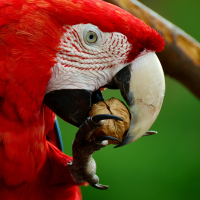Training Your Pet Parrot
Parrots are wonderful pets. You will quickly find that these birds extremely smart and their ability to learn make them fun to train. Keep in mind that any animal that shows signs of high intelligence can easily get bored, so your job is to train your pet parrot and spend the time it takes to make your bird into a wonderful pet. It takes time and patience to train a parrot, but with the proper training, your parrot will provide you with many years of friendship.
You can train your parrot when you follow a few steps. Whenever “school is in” for your parrot, it is always best to remove your parrot from his or her cage and train in a small quiet space. Your parrot is more likely to remain attentive and retain information when it is in a new environment. The next thing you will want to do, eliminate all distractions in your home. If your parrot becomes distracted during training, it will not learn well. That means that you need to turn off the radio, television and perhaps even the telephone. Also, remember that parrots are a lot like children. They have short attention spans, so short training sessions are recommended.
In addition, try to plan your parrot’s training time around their schedule, not yours. After mealtime is always, a good time for training because your parrot will be content and will pay attention. Your parrot will also appreciate plenty of praise. Even if you find that you were not very successful, do not let your parrot see your stress levels rise. This makes it an unpleasant experience for your bird and you will have a harder time getting your parrot interested in learning in the future.
When you are ready to teach your parrot a new trick, your pet parrot will respond well to treats and praise. Remember that all animals respond better to praise than punishment. Try to avoid punishing your parrot, even if he or she is acting naughty. Ignoring this behavior is your best bet when training your pet parrot. Parrots do not understand punishment or negative reinforcement. In fact, if you respond to your parrot’s bad behavior, your pet may actually see this as positive attention. Keep in mind that while your parrot will love food treats as rewards, try to accentuate the positive and encourage good behavior with lots of praise and play time. Otherwise, your parrot may only perform the tricks you want them to when some kind of food reward is available.
Repetition is the key to successfully training your pet parrot. Repeating these basic steps repeatedly until your pet “gets” the trick is the best way to train your parrot to perform. This works well for basic commands and advanced tricks. If you have just gotten your pet parrot, start out with very simple tricks, such as teaching your parrot to sit on your finger on command. Find a word for each trick and use it every time you train. Most of all, never force your parrot to train. If you find your parrot is tired or uninterested, then stop and try again another time.
As your parrot learns more command and tricks, you can begin moving your training session closer and closer to the bird’s cage. As they get better at their new skill, they will feel comfortable performing in his or her cage and in the hustle and bustle of your household. Birds learn quickly in most cases, and sometimes just by listening when not in training, which may cause embarrassment to you if they learn something inappropriate.
Training a parrot takes a lot of time and patience. You must love your bird and have a lot of time and dedication to make this partnership worthwhile. With patient training and love, you end up with a fantastic and well-behaved pet that will be with you for a very long time to come.




